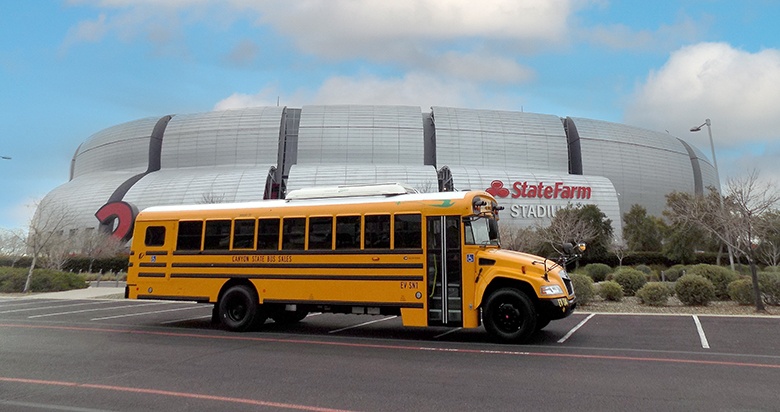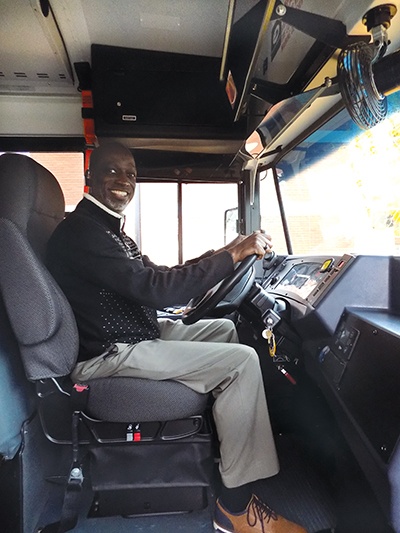
Although Blue Bird’s all-electric Type C school bus launched in 2019, the manufacturer is no stranger to electric vehicles (EVs). The company rolled out its first electric bus nearly 30 years and has closely monitored and developed the technology since then. With the latest iteration of the Vision Electric, Blue Bird said it has struck a balance between range, charge time, capacity, and affordability.
The Vision Electric school bus seats up to 77 passengers with a GVWR of up to 33,000 pounds. Powered by Cummins PowerDrive lithium ion NMC batteries, the vehicle can travel up to 120 miles on a single charge. Districts can charge the bus overnight, reaching maximum charge in eight hours using a Level 2 (AC) charger or 3 hours using a Level 3 (DC) fast charger.
In developing its portfolio of electric offerings, Blue Bird sought to create affordable, low-cost-of-operation EVs – with the goal of making EV implementation and ramp-up as easy as possible for its school district customers. And today – with hundreds of thousands of dollars available in grants and incentives for electric adoption – electric vehicle purchasing and acquisition costs for school districts have never been lower.
“After four years of production, Blue Bird now has more than 900 electric buses on the road and in service,” said Albert Burleigh, Blue Bird’s executive director of electric vehicle business development. “We have sold upwards of 1,400 units, some of which are still in production. At that scale, we’ve been able to maintain the standard features and layout to which our drivers are accustomed. For them, the bus itself is very similar to the other Blue Bird products in their fleet– the only difference is the powertrain.”

Easing EV Adoption
The Blue Bird Vision is so named due to its increased driver visibility and maneuverability over other models, but it also shares parts and component commonality with other Blue Bird buses – allowing for easier maintenance and lower cost of ownership for districts and operators. The Vision Electric is equipped with a direct drive motor which doesn’t require the use of a transmission. This improves performance and saves on cost, weight, and maintenance. With fewer moving parts than its diesel counterpart, the Vision Electric represents a much lower cost of maintenance than traditional school buses.
The Vision Electric Type C comes standard with V2G (vehicle-to-grid) technology for bi-directional charging. With this feature, the bus provides for the potential of sending excess electricity back into the grid and thus bringing extra funds to the district.
Burleigh said that, with the Vision Electric’s advanced thermal management system, districts can realize better performance while operating in less-than-ideal weather conditions. This system provides cabin heat for passengers and also monitors and maintains battery temperatures to optimize efficiency and range.
The Vision bus features the company’s patented NextGen Seating solution, allowing for easier conversion when districts want to reconfigure the vehicle’s seating. By simply removing four bolts from the base, districts can easily install new seats of their choice. The seat converts from Lap Belt Ready to 3-Point Belts or Child Restraint, depending on the needs of the end user.
For the driver, an ergonomic cockpit allows comfort for almost all body types. The Vision Electric’s instrument panel is functionally the same as its diesel counterpart, meaning that most drivers can easily adjust if they are already used to driving Blue Bird vehicles.
As with all Blue Bird buses, the Vision Electric features Electronic Stability Control (ESC), Hill-Hold, and backup cameras. In addition to meeting and exceeding U.S. Federal Motor Vehicle Safety Standards and Canada Motor Vehicle Safety Standards, the bus is Colorado Rack Test and Kentucky Pole Test certified.
The bus is equipped with more standard features to which Blue Bird customers have become accustomed: easy-to-service stepwells, zero-maintenance fasteners, easy windshield replacement, improved window seals, rub rail protection, all-steel frame rails, and the industry’s largest bumpers (measuring 15 inches tall). It is backed by Blue Bird’s massive dealer and Cummins service network, with over 335 vehicle service centers available to districts across North America.
Test Driving the Blue Bird Vision Electric
School BUSRide met with Blue Bird representatives at Canyon State Bus Sales in Glendale, Arizona. Along with Burleigh, we were joined by Canyon State Bus Sales CEO Michael McGrath and General Manager Justin Honeycutt.
Canyon State Bus Sales is the factory-authorized Blue Bird and Micro Bird school, activity, and commercial bus dealer for Arizona. With a team of Blue Bird service and parts specialists, Canyon State Bus Sales has one of the largest school bus parts inventory in the state.
For the test drive, School BUSRide enlisted the help of Dr. Kerry Duskin, transportation director for Roosevelt Elementary School District #66 (RSD) in Phoenix, Arizona. Duskin has seen it all in his 33 years of working with schoolchildren – as a special education teacher, a dean of students, principal, and in his current position.
Roosevelt Elementary School District #66 encompasses the Phoenix area between the Salt River (in the northern valley) and South Mountain, and bounded by 40th Street and 35th Avenue in the east and west, respectively. The largest employer in all South Phoenix, the district serves more than 8,900 students across 20 schools.
Prior to the test drive, Duskin had only driven one electric bus – a Blue Bird model from Canyon State Bus Sales during a local parade. This drive would be his most thorough review of an EV.
Duskin pulled out of the Canyon State Bus Sales parking lot in the Vision Electric, beginning to navigate the Glendale neighborhoods surrounding the dealership. Coming to several stops at neighborhood intersections, Duskin commented that the ride was much smoother than his previous experience with diesel buses.
“It’s a much quieter ride,” he said. “Coming into the drive, I was trying to get a little extra speed so I could see how the regenerative braking works. For the most part, it’s easier to brake than in a diesel bus.”
Having participated in numerous Blue Bird educational programs and sessions, Duskin said he was likely having an easier time adapting to electric driving than some drivers might.
“In those sessions, we’re given a lot of information about how to handle and drive electric vehicles,” he said. “It’s easy to pull from that memory now, as far as understanding braking and driving. For example, in an electric bus like this, it’s best to just release the gas and let the vehicle brake itself with the regen.”
Duskin said a typical morning route for an RSD driver only takes about 10 minutes, with all driving taking place on the city streets. The longest drive in the district, he said, is about 30 minutes. He noted that the Vision Electric would have no problem sliding into the current routes under these conditions.

All the same, Duskin took the bus from the streets of Glendale and on to the US Highway 60 West, intending to put the Vision Electric through its paces.
Upon reaching highway speed, Duskin was impressed with the vehicle’s takeoff and acceleration.
“I liked it,” he said. “The takeoff was just a lot smoother than with a diesel bus. I gave it some power and it’s ready to go – like I’m driving a big car.”
Turning on to Arizona State Route 101, Duskin noted that the turning radius to this point was impressive.
“I’m partial to Blue Bird buses, but I’m very comfortable with this turning radius,” he said. “I could probably do a complete U-turn in this bus without backing up much, based on what I’ve seen. We find that Blue Bird turning works well for our district, especially in some areas where our smaller buses need to make tight maneuvers.”
During Duskin’s review of the dashboard, Burleigh pointed out that Blue Bird replaced the traditional tachometer with an efficiency gauge on the Vision Electric. The gauge oscillates between yellow and green, providing a visual to help drivers drive as energy efficiently as possible.
As Duskin activated the regenerative braking, the meter moved into the green area. With faster acceleration, the meter stays in the yellow.
“It’s just a visual reminder, an indicator to show drivers when they’re driving efficiently,” Burleigh said. “Many of our customer districts have realized tremendous savings simply from adjusting driver behavior in EVs.”
Duskin agreed, saying he thought the hardest adjustment for drivers (who are new to EVs) would be learning the regenerative braking process.
“Even as I drive here, I have caught myself wanting to just hit the brakes as we approach a stop,” he said. “I have to remind myself that I need to just start slowing down and take advantage of the regen.”
Final Thoughts
Duskin ultimately observed that, throughout the test drive, the vehicle’s battery maintained a healthy level of charge. The drive ran for approximately 11 miles, simulating a Roosevelt route length, and the dashboard was consistent in its readings.
Pulling back into Canyon State Bus Sales, Duskin was effusive in his final assessment.
“With this regen, I could probably get two days of run out of one charge at RSD,” he said. “It’s totally different from diesel, so it’s an adjustment. But overall, I would recommend checking this out. It’s a worthwhile investment.”


